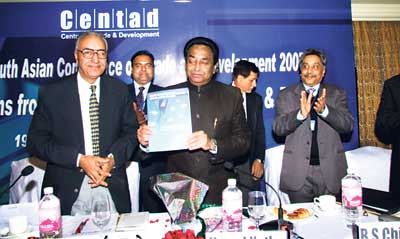
Food and fuel biggest challenges for SA countries – Kamal Nath
New Delhi -- Food and fuel will be the biggest development challenges for South Asian countries, says India’s Minister of Commerce and Industry. Speaking at the third South Asia, Regional Conference on Trade and Development organised by the Centre for Trade and Development (CENTAD), India last week, Minister Kamal Nath said the increasing prices of food and fuel would be the biggest obstacle to development of South Asian countries in the future. “There are two challenges that have emerged in the last few years. These are the challenges of the two Fs; food and fuel,” he said. Sri Lanka is among the net food importers of the region, such as Bangladesh, Nepal and Maldives. But the increased demand for food, is seen throughout the region and is not limited to the net food importers. “In India around 15 million people have moved from having just one meal a day to having two meals a day. There is another 15 million in Bangladesh and Pakistan. So that is 30 million people going from one meal a day to 2 meals a day,” said Nath.With increased demand, even large agricultural producers like India, are beginning to feel the pressure of increasing food prices. Prices of food could increase further as a result of international trade talks at the World Trade Organisation (WTO). Despite price increases, food prices are still being kept artificially low through agricultural subsidies in developed countries. This is because farmers in rich countries get massive government subsidies that allow them to sell their production at prices lower than actual production costs. “The collective agricultural subsidy in the developed world is estimated at around US$ 1 billion per day,” said Muhammad Saeed from the permanent mission of Pakistan to the WTO, speaking at the conference. So large agricultural producers like India and Pakistan are demanding that these ‘trade distorting’ agricultural subsidies be removed, to allow fair competition. Removing these subsidies would also increase prices of food. The worst impacted would be net food importers like Sri Lanka. However, trade experts say removing trade distorting agricultural subsidies could, in the long term, be beneficial to all. “Food prices will increase if subsidies are removed but the impact may not be so bad. Removing the subsidies will allow farmers in all the countries to compete and will encourage food production. So this may increase domestic food production,” said Linu Mathew Philip, a research officer at the CENTAD. Increasing food production in India in particular, is expected to benefit the entire region. “For instance, for Bangladesh and Nepal, food aid is very important. Much of this aid comes from India. So if India experiences food insecurity it will spread very quickly throughout the region. So if India can increase its food production capacity, it would benefit the entire region,” said Philip. However, the Indian government says, given the limitations on land, the solution is to develop commercial agriculture and for more people to move away from agriculture into services and manufacturing. Trying to protect farmers by restricting imports (by putting up import duties) will not work, said Nath. “There are 650 million farmers in India but they are not in commercial agriculture. They are in subsistence farming. Keeping tariffs high will continue to keep them in distress. High tariffs have kept our farmers in distress. The only answer is for people to move away from farming. Unless agriculture becomes commerce it will not be possible to extricate the farmers. 100 to 200 million people will have to move away from agriculture into manufacturing and services,” the minister said. The Indian Minister of commerce and industry said these agricultural reforms will be the second agricultural revolution in the country. “Reforms in agriculture will be the second agricultural revolution. The first one made us self sufficient but it will be the second one that will set the direction of development,” said Nath. |
|
||
| || Front
Page | News
| Editorial
| Columns
| Sports
| Plus
| Financial
Times | International
| Mirror
| TV
Times | Funday Times || |
| |
Reproduction of articles permitted when used without any alterations to contents and the source. |
© Copyright
2007 | Wijeya
Newspapers Ltd.Colombo. Sri Lanka. All Rights Reserved. |
